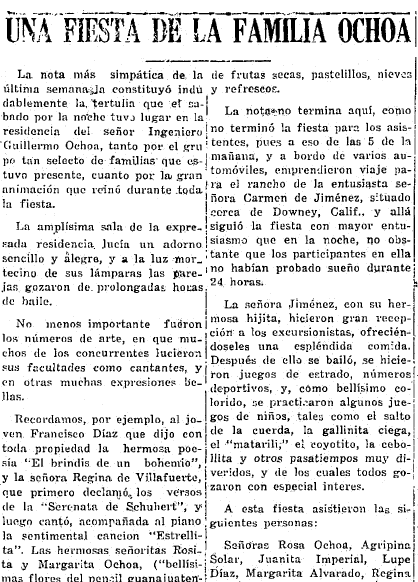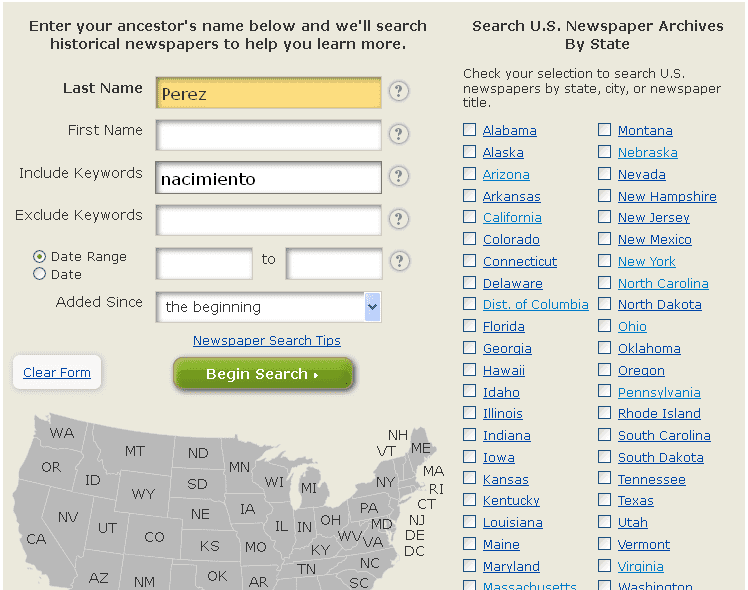Introduction: Has National Hispanic Heritage Month inspired you to research your Hispanic ancestors – yet you’re not sure how to go about it because you don’t speak Spanish? In this article, Gena Philibert-Ortega gives practical tips and describes online resources to help you overcome this family history challenge. Gena is a genealogist and author of the book “From the Family Kitchen.”
What are your favorite genealogy projects to work on? Mine typically involve English-language records. Let’s face it, when you only speak/read/write English those are the genealogy records that you feel most comfortable using.
So what happens when you have to research outside of your comfort zone – such as researching Hispanic ancestors when you don’t know how to speak or read the Spanish language? Well, for one thing: it’s time to start planning your Hispanic ancestor research.
A basic genealogy tip is to start with yourself and work back through each generation. In this case, after you do that, focus on your immigrant ancestors and exhaust records in the United States, then work on records found in their homeland.
Here are three other tips to keep in mind.
1) Start your timeline. I’ve written about timelines on the GenealogyBank blog before (see: Genealogy Timelines: Helpful Research Tools), and it’s worth taking the time to re-read that article. Organize what you know about your Hispanic ancestors with a timeline, and then study it for gaps in information. Ask yourself what events you should be searching for, such as births, marriages, and deaths. Consider historical events that may have affected your ancestors on a personal level and would have resulted in records. For example: military service during a war. As you study your timeline, what events impacted your family?
You can learn more about historical events in your ancestors’ homeland by consulting online history timelines. And very important: don’t neglect to read online historical newspapers, such as those in GenealogyBank’s Hispanic American Newspaper Archives.

These Spanish-language newspapers were published in the United States, but they also report on events in other countries and can be a valuable resource for better understanding a historical era. These historical Hispanic American newspapers covered events important to the community they served, and provided a perspective not found in the larger city newspapers. GenealogyBank’s Hispanic American Newspaper Archives include newspapers from the early 19th century.
2) Read Spanish-language newspapers. It may seem strange to suggest reading Spanish-language newspapers when you don’t know how to read Spanish. Don’t let Spanish-language newspapers intimidate you. I don’t read Spanish either, but with today’s online tools it’s never been easier to “read” a foreign language.
It’s helpful to become familiar with genealogically-relevant words in the new language you’re trying to understand. What’s genealogically-relevant mean? It depends on what you’re researching, but some words to begin with include those for birth, marriage, baptism, death, and familial relationships. Combining a name and a Spanish-language keyword in the search box will help you narrow down results when researching a common name. Consult the Spanish Genealogical Word List on the FamilySearch Wiki for words to become familiar with. I would also recommend investing in a Spanish-English dictionary for quick lookups. These two tools will assist you as you research Spanish-language documents.
For example, here’s a search for Perez birth records in GenealogyBank.
One of my favorite resources for Spanish-to-English language translations is the website Google Translate. While not a perfect language translation tool, it can help you better understand what you are reading. You can use the Google Translate website on your computer or on the go with the Google Translate app. The translation app allows you to speak, scan, type or draw text. The app will even translate text from a photo. Translations can be saved in an online Phrasebook for future reference. Consult the web page for Google Translate Help for information on using these features.
3) Learn more. Perhaps you aren’t just researching your Hispanic ancestors’ vital statistics, but instead verifying a family story. In my family, one story involves being forcibly chased out of Mexico by Pancho Villa. You might have a similar story that you want to verify.

Good family history research is searching for records, but also learning more about a place in time so that you can find additional documents that you need. Use books and periodicals to learn more about an area and the events your Hispanic ancestors were a part of. Search on the event and read newspapers published throughout the United States archived on GenealogyBank. Join societies like the Genealogical Society of Hispanic America to learn more about research and to benefit from their publications, meetings, and conferences. Genealogy research is so much more than just doing look-ups for dates and places; it takes time to immerse yourself in the material that will help you document your ancestors’ lives.
Researching Hispanic ancestors and you don’t know how to speak or read Spanish? No problem! Take some time to formulate a genealogy research plan and learn more about what you should be researching – and you will be on your way to adding more information to your family tree!
Related Hispanic American Genealogy Articles & Resources:

